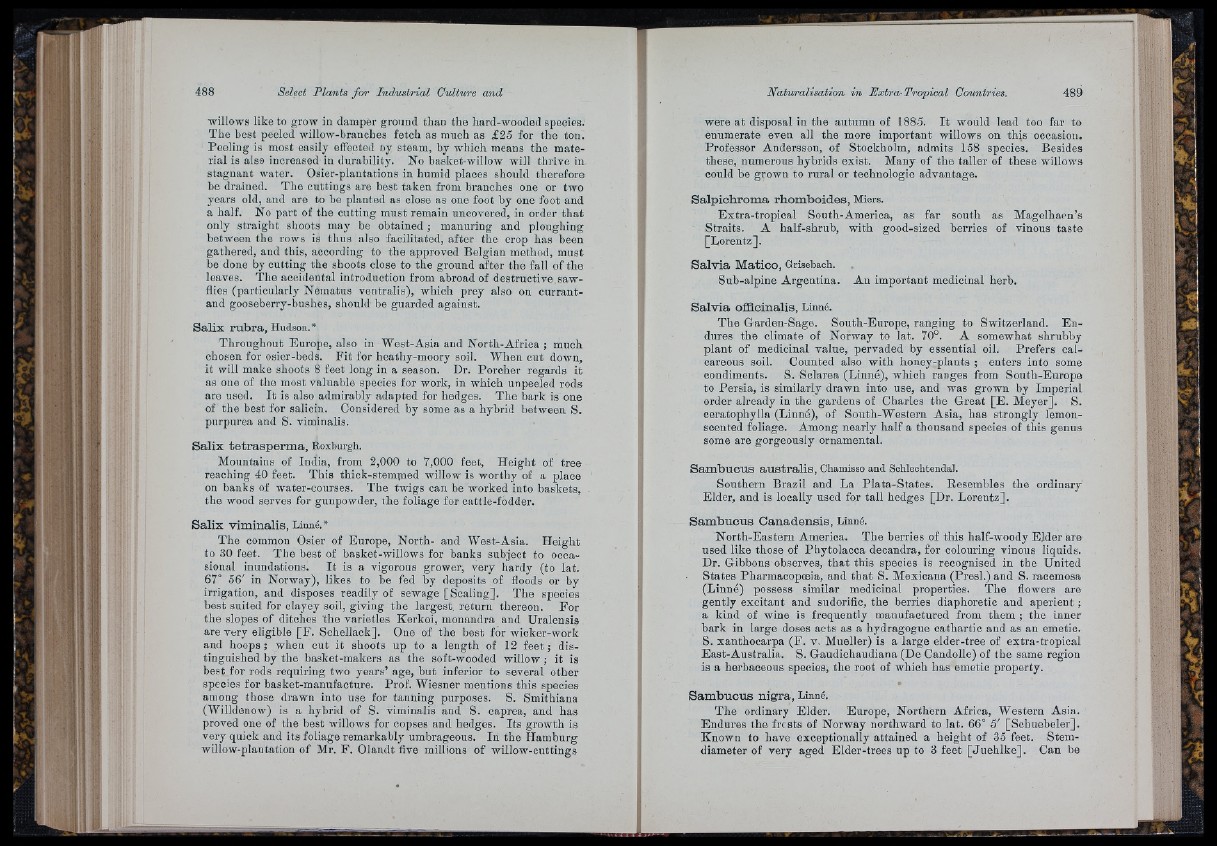
willows like to grow in damper ground than the hard-wooded species.
The best peeled willow-branches fetch as much as £25 for the ton.
Peeling is most easily effected by steam, by which means the material
is also increased iu durability. No basket-willow will thrive iu
stagnant water. Osier-plantations in humid places should therefore
be drained. The cuttings are best taken from branches one or two
years old, and are to be planted as close as one foot by one foot and
a half. No part of the cutting must remain uncovered, in order th a t
only straight shoots may be obtained ; manuring and ploughing
between the rows is thus also facilitated, after the crop has been
gathered, and this, according to the approved Belgian method, must
he done by cutting the shoots close to the ground after the fall of the
leaves. The accidental introduction from abroad of destructive saw-
flies (particularly Nematus ventralis), which prey also on currant-
and gooseberry-bushes, should be guarded against.
S a lix ru b r a , Hudson.*
Throughout Europe, also in West-Asia and North-Africa ; much
chosen for osier-beds. F it for heathy-moory soil. When cut down,
it will make shoots 8 feet long in a season. Dr. Porcher regards it
as one of the most valnable species for work, in which unpeeled rods
are nsed. I t is also admirably adapted for hedges. The bark is one
of the best for salicin. Considered by some as a hybrid between S.
purpurea and S. viminalis.
S a lix te t r a s p e rm a , Roxburgh.
Monntains of India, from 2,000 to 7,000 feet. Height of tree
reaching 40 feet. This thick-stempied willow is worthy of a place
on banks of water-courses. The twigs can be worked into baskets,
the wood serves for gunpowder, the foliage for cattle-fodder.
S a lix v im in a lis , Linné.*
The common Osier of Europe, North- and West-Asia. Height
to 30 feet. The best of basket-willows for banks subject to occasional
inundations. I t is a vigorous grower, very hardy (to lat.
67° 56' in Norway), likes to be fed by deposits of floods or by
irrigation, and disposes readily of sewage [Scaling]. The species
best suited for clayey soil, giving the largest, return thereon. For
the slopes of ditches the varieties Kerkoi, monandra and Uralensis
are very eligible [F . Schellack]. One of the best for wicker-work
and hoops ; when cut it shoots up to a length of 12 feet ; distinguished
by the basket-makers as the soft-wooded willow ; it is
best for rods requiring two years’ age, but inferior to several other
species for hasket-manufacture. Prof. Wiesner mentions this species
among those drawn into use for tanning purposes. S. Smithiana
(Willdenow) is a hybrid of S. viminalis and S. caprea, and has
proved one of the best willows for copses and hedges. Its growth is
very quick and its foliage remarkably umbrageous. In the Hamburg
willow-plantatiou of Mr. F . Olandt five millions of willow-outtings
were a t disposal in the autumn of 1885. I t would lead too far to
enumerate even all the more important willows on this occasion.
Professor Andersson, of Stockholm, admits 158 species. Besides
these, numerous hybrids exist. Many of the taller of these willows
could be grown to rural or technologic advantage.
S a lp ic h rom a rh om b o ïd e s , Miers.
Extra-tropical South-America, as far
Straits. A half-shrub, with good-sized
[Lorentz].
south
berries
IS Magelhaen’s
of vinous taste
S a lv ia M a tic o , Grisebach.
Sub-alpine Argentina. An important medicinal herb.
S a lv ia o fflc in a lis, Linné.
The Garden-Sage. South-Europe, ranging to Switzerland. E n dures
the climate of Norway to lat. 70°. A somewhat shrubby
plant of medicinal value, pervaded by essential oil. Prefers calcareous
soil. Counted also with honey-plauts ; enters into some
condiments. S. Sclarea (Linné), which ranges from South-Europe
to Persia, is similarly drawn into use, aud was grown by Imperial
order already in the gardens of Charles the Great [E. Meyer]. S.
ceratophylla (Linné), of South-Western Asia, has strongly lemon-
scented foliage. Among nearly half a thousand species of this genus
some are gorgeously ornamental.
S am b u c u s a u s t r a lis , Chamisso and Schlechtendal.
Southern Brazil and La Plata-States. Resembles the ordinary
Elder, and is locally used for tall hedges [Dr. Lorentz].
S am b u c u s C a n a d e n s is , Linné.
North-Eastern America. The berries of this half-woody Elder are
used like those of Phytolacca decandra, for colouring vinous liquids.
Dr. Gibbons observes, that this species is recognised in the United
States Pharmacopoeia, and th a t S. Mexicana (Presl.) and S. racemosa
(Linné) possess similar medicinal properties. The flowers are
gently excitant and sudorific, the berries diaphoretic and aperient ;
a kind of wine is frequently manufactured from them ; the inner
bark in large doses acts as a hydragogne cathartic and as an emetic.
S. xanthoearpa (F. v. Mueller) is a large elder-tree of extra-tropioal
East-Australia. S. Gaudichaudiana (De Candolle) of the same region
is a herbaceous species, the root of which has emetic property.
S am b u c u s n ig r a , Linné.
The ordinary Elder. Europe, Northern Africa, Western Asia.
Endures the frcsts of Norway northward to lat. 66° 5' [Schuebeler].
Known to have exceptionaliy attained a height of 35 feet. Stem-
diameter of very aged Elder-trees up to 3 feet [Ju eh lk e ]. Can be